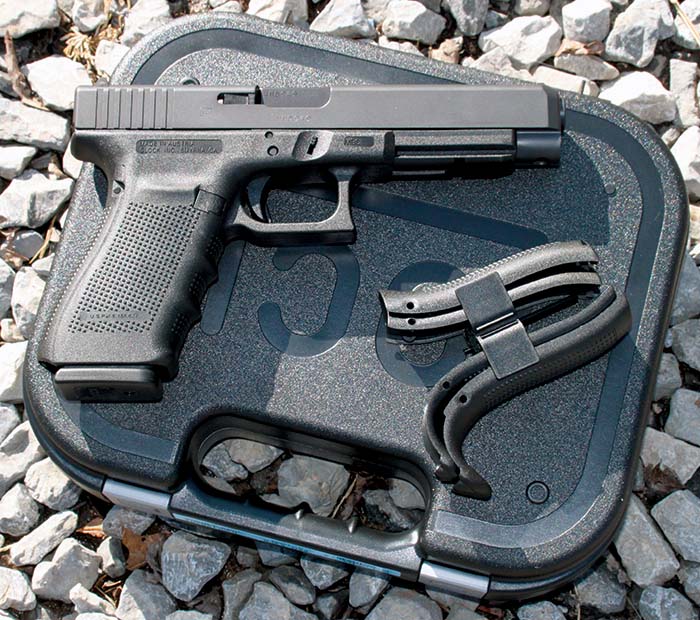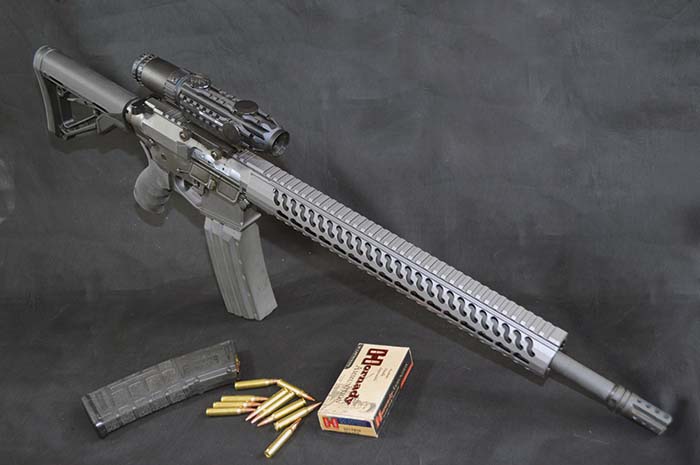Battle Arms Development Ambi Safety/Selector (item BAD-CASS-FA). This kit features interchangeable levers in 6 sizes and shapes. Ambidextrous control means quick control.
By Todd Burgreen
Glock made noteworthy additions to their product lineup at the latest SHOT Show with the Glock 41 (G41) .45 ACP and Glock 42 (G42) .380 ACP. These two new Glock handguns are on opposite sides of the use spectrum. The G41 is a dual purpose “Tactical/Practical” full size weapon equally at home in duty/service roles or in competition formats. The G42 is an ideal concealed carry candidate. The focus of this article is on the Glock 41. After erupting on the scene in the early 1980s with the Glock 17 (G17), Glock pistols quickly evolved into a benchmark for personal defense, law enforcement, and military polymer handguns. Glock handguns are ultra reliable, accurate, tough, and simple to operate; all at a competitive market price. A review of the personal defense handgun market makes it clear that Glock is a design standard for these materials, that many others are still chasing. Many detractors would have you believe that Glock has grown complacent by not introducing any new designs that depart significantly from the template laid by G17’s arrival in 1982. In fact, Glock handguns are into their Fourth Generation (4th Gen) of refinement being introduced at the 2010 SHOT Show. The 9mm G17 and .40 S&W G22 were the first models introduced in the Fourth Generation with the other models steadily added.
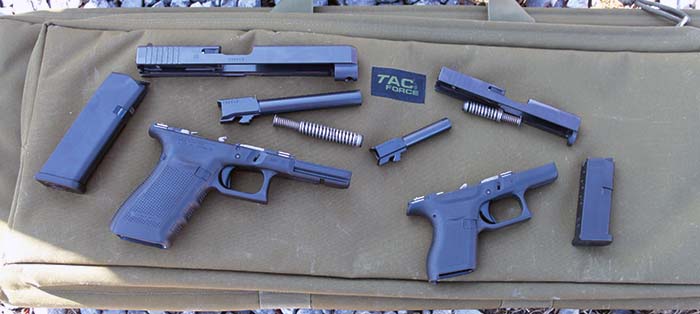
A quick rundown of what sets each Glock Generation apart is in order to better appreciate Glock evolution. The 1st Generation, typified by the G17 introduced in the early 1980s, was created to satisfy the Austrian Ministry of Defense request for a new service pistol replacing the P38. The grip was smooth with little texturing and no accommodation made for lights or other accessories to attach to the frame. 2nd Generation Glocks had serrations added to the front and back strap of the frame. A steel plate stamped with serial number was embedded into 2nd Generation frames at the dust cover to satisfy U.S. BATF regulations. Research indicates that 1st and 2nd Generation Glocks were built with two pin frames with all subsequent models using a three pin frame. Third Generation Glocks were introduced in the late 1990s. Highlights of the Third Generation consisted of an accessory rail (Universal Glock rail) being standard for the use of lights, lasers and other accessories. Thumb rests were added on both sides of the frame and finger grooves were added to the front strap. “Late” Third Generation Glocks had the extractor modified to serve as a loaded chamber indicator. As mentioned above, Third Generation Glocks had an additional cross pin added. The pin is labeled as the locking block pin and is located above the trigger pin. The locking block is enlarged in the Third Generation Glocks. The larger locking block and additional pin was added for increased durability and distributes force across a larger area.
The 4th Generation Glock reflects a combination of both ergonomic and internal changes. Many will point to Glock finally acceding to market demand by offering interchangeable backstraps of different sizes with the 4th Generation introduction. It is suspected the increasing amount of competitors offering the ability to change grip sizes was making too many inroads into both the law enforcement and civilian markets. Grip sizes are small, medium, and large frame. Grips are changed via removing a single pin. The G41 Gen 4 Glock comes with a smaller integral grip compared to the Gen 3 Glocks with the medium and large grips fitting over the frame as a user sees fit. Basic grip size is smaller with the 4th Generation introductions due to Glock lessening the backstrap “hump.” This aids shooters with smaller hands by reducing the circumference of the grip frame. Adding the medium grip size of the 4th Generation Glock can be likened to the grip found standard on 3rd Generation Glocks. The magazine catch on the 4th Gen Glock is enlarged and reversible requiring no additional parts to do so. 4th Generation Glocks come with three magazines configured with the cutout catches on either side of the magazine body. All previous Glock magazines will work with the 4th Generation Glock as long as the magazine catch is configured on the frame’s left side.
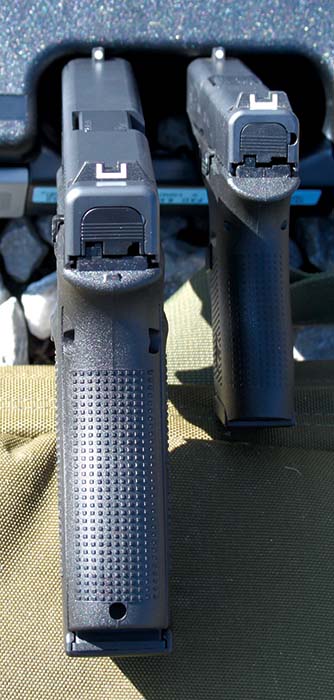
Internal changes associated with the Gen 4 Glock centers around the dual recoil spring similar to what is currently found in the “mini” Glock 26/27. Glock literature points to the dual recoil spring assembly reducing recoil impulse and increases the life cycle of the pistol by limiting wear due to the firing cycle. Non-Glock sources point to the dual spring as a necessary change to address reports of reliability issues with G22s when shooting certain types of ammunition with a light mounted to the weapon. The dual spring changes slide rate and thus reliability. The spring is a dual compression type with the captured springs operating at different rates. Though no formally tested recoil dampening rate reports have been published, subjective estimates from 10%-30% have been bantered about, especially with the “snappier” .40 S&W and .357 SIG chambered Glocks. The G41 tested herein in a 4th Generation type. The dual recoil spring is expected to have a longer service life compared single spring design found in earlier generation Glocks.
Glock eliminated the possibility of switching springs and slides between 4th Generation models and its predecessors by giving the dual recoil springs a thicker guide rod and end plug so it will not fit in any non-4th Generation slide. The Gen 4 slide has been altered to not accept previous guide springs and furthermore prevents slide interchangeability between Gen 4 and earlier Generation models. Gen 4 slides are stamped accordingly to aid in preventing confusion. Another internal change is in the trigger bar layout and is supposed to increase life expectancy. The trigger housing is slightly different due to the grip frame and mirrors Gen 3 SF models.
Manufacturer and price range serve as no guarantee that a handgun is able to perform immediately after purchase. Yes, many deficiencies are quickly remedied by “breaking in” a pistol by use or making slight adjustments to various parts. This does not have to be acceptable. A Glock is one of the few handguns you can count on being ready to go straight out of the box. Glock’s solid performance over the years is sometimes neglected or taken for granted, particularly by firearms publications. This stems from the constant focus on the newest product introductions. The G41 allows for renewed focus on what Glock offers in terms of performance.
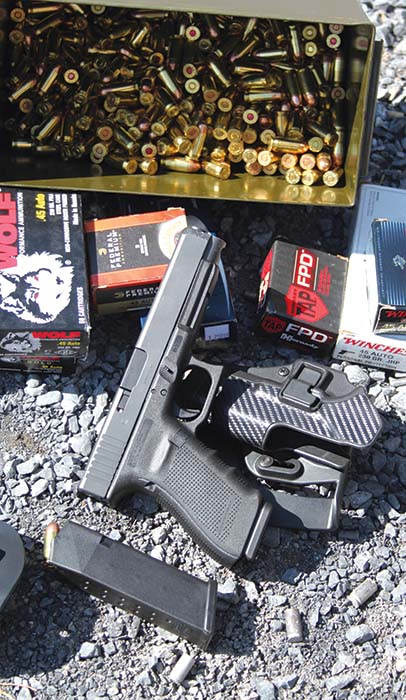
The G41 joins other specialized Tactical/Practical “long slide” Glocks such as the G34 (9mm) and G35 (.40 S&W). The Glock Tactical/Practical family tree extends back to the hard to find G17L (9mm) and G24 (.40 S&W). The Glock 34 and 35 were born from the need to shorten the slide of the G17L/24. The G34/35 slide was shortened to fit size constraint rules imposed by certain competitive shooting sanctioning bodies. In general, the dimensions follow the classic 1911 pistol’s outline. With the G34/G35 introduction, G17L and G24 production was throttled back. Glock’s reasoning, as efficient as their handguns were, was that there was no need to continue importing the Glock 17Ls and G24s in the same quantity with the Glock 34/35’s introduction.
Let’s review what sets the Glock 41 apart from other Glock handguns outside of the Tactical/Practical category. This is an instance where size does matter. The G41’s 5.3 inch barrel is the most obvious departure giving the G41 an overall length of 8.9 inches and a sight radius of nearly 7.6 inches. For comparison’s sake, a full size 1911 has a sight radius of 6.8 inches. The G41’s longer sight radius is more conducive to accurate shot placement at distance. With the G41 a proficient shooter will find it possible to accurately engage targets at 50 yards and cover had better be sought by any intended targets out to 100 yards. Proven Glock ergonomics combined with the slide’s long track during recoil and manageable .45 ACP muzzle signature allows for a very stable sight picture no matter how many or how rapid rounds are fired.
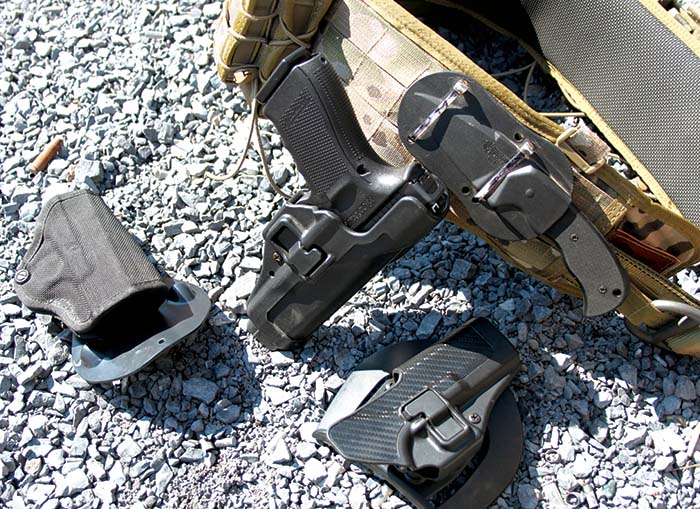
It is not hard to fathom why select elite special operation units choose the Tactical/Practical “long slide” G34/35 Glocks with the G41 sure to follow the same path. The G41 equipped with a Glock GTL 21 tactical laser/light on its rail is a lethal CQB weapon in trained hands. Another worthy addition would be a Kriss Extended G21 magazine offering 25-round capacity for the G41. This same configuration, GTL 21 and Kriss Extended G21 magazine, would find beneficial use in the civilian world as a “nightstand” defensive handgun.
A loaded G41 magazine with one in the chamber adds up to fourteen rounds of potent .45 ACP firepower in a package similar in size to the classic 1911. The G41 represents the quintessential balance of size, weight, capacity, and cartridge potency. As mentioned earlier, the G41’s frame is a Gen 4 type, meaning it is not as large as the previous Gen 3 G20 (10mm) / G21 (.45 ACP) frame that proved such a handful – no pun intended – for anyone without extra-large hands. The prior 4th Gen reference is important due to the G41 benefiting greatly from the associated design tweaks. The G41 comes with four (4) interchangeable backstraps allowing a user to adjust to the feel they want. Two grips featuring extended beavertails are also included with the G41. Another nuance discovered with the Gen 4 G41 was that its slimmer slide resembles a G17 compared to a G20/21 allowing for its use in a wider range of holsters. This is significant with G17 holsters more easily available than G20/21 holsters. The G41’s slimmer slide contributes to it weighing less than a G21. The G41 weighs 27 ounces empty; this is a couple ounces less than the G21 despite its shorter slide.
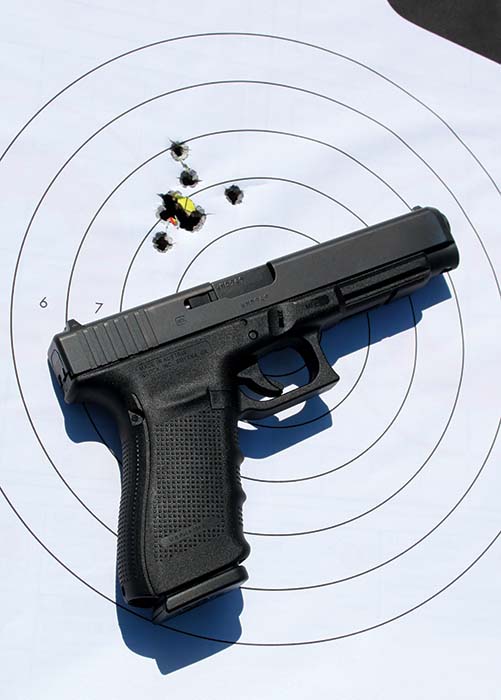
The G41 .45 ACP was test fired using Federal, Winchester, Black Hills, Hornady and Wolf ammunition. Loads fired ranged from 185 grain to 230 grain JHP and FMJ bullets. Brass and steel cases were also tested in the G41. Approximately 450 rounds were fired while compiling this article. No malfunctions were experienced. After the G41 sights were verified at 25 yards, T&E testing consisted of monotonous hammering of steel plate racks and popper targets at 7, 15, and 25 yards. Man sized steel targets were sporadically engaged at 50 and 100 yards as well. All of the premium loads tested from Federal, Winchester, Black Hills Ammunition, and Hornady generated 3-inch groups at 25 yards. From a more practical perspective in terms of handgun performance, the G41 produced a 100% rating over a 60-round law enforcement proficiency test frequently used to gauge different handguns. The test is timed fire from the holster at various ranges stretching from 5 yards back to 30 yards. Unscientific assessment would be that the “snap” of the slide in its rearward travel is indeed reduced with the G41 compared to a 3rd Gen G21 .45 ACP that was handled alongside it even though the G41 is lighter than the 3rd Gen G21 by a few ounces. This has to be attributed to the dual recoil spring found in the G41.
T&E was conducted at Echo Valley Training Center, a private range located near Winchester, VA, where many local and federal law enforcement tactical team members train. It is difficult to convey how many shooters at the range perked up when they noticed the Glock 41. Every time one of them got to handle and shoot the Glock 41, a convert was obtained. Their duty weapons span the gamut, including custom tuned 1911 pistols, but all appreciate what the G41 offers in terms of accuracy, reliability, handling, capacity, and lethality.
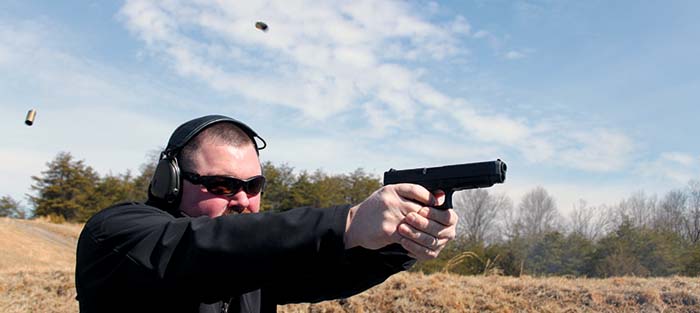
Considering that the G41’s design intent as a Tactical/Practical offering it was decided to dedicate some time evaluating the G41 using several drills experienced during training at Suarez International, TMACS, Tactical Response, Storm Mountain, and other schools. Drills included working around breaching facades, door entries, and other CQB activities typified by experiences encountered in shoot house environments. A premium is placed on a quick handling accurate handgun such as the G41 with multiple rounds fired in quick succession the norm to put a target down. The natural point-ability of the G41 comes into its own in this realm. The full size grip frame and overall balance of the G41 made felt recoil negligible. A BlackHawk Serpa holster on a High Speed Gear patrol belt served as primary means of carry for evaluation purposes.
The Glock “secret” to success is minimal operating controls, relentless reliability, and consistent manageable trigger pull. While the grip size is different between the newly introduced Glock 41 and Glock 42, the position of the slide and magazine releases will instantly be familiar. Simplicity should not be confused as lack of refinement. As experience and knowledge has expanded, Glock reliability and solid performance has become more entrenched as a standard that many other polymer handgun manufacturers are competing against.
Sites of Interest
Glock
6000 Highlands Pkwy
Smyrna, GA 30082
(770) 432-1202
www.glock.com
Black Hills Ammunition
PO Box 3090
Rapid City, SD 57709
(605) 348-5150
www.black-hills.com
Echo Valley Training Center
www.echovalleytrainingcenter.com
Hornady Mfg., Inc.
3625 Old Potash Hwy
Grand Island, NE 68802
(800) 338-3220
www.hornady.com
Stonewall Arms
2438 Valley Ave
Winchester, VA 22601
(540) 535-2190
www.stonewallarms.com
Winchester Ammunition
427 N. Shamrock St
East Alton, IL 62024
www.winchester.com
KRISS USA
PO Box 8928
Virginia Beach, VA 23450
(855) 574 7787
www.kriss-usa.com
| This article first appeared in Small Arms Review V19N1 (January 2015) |



